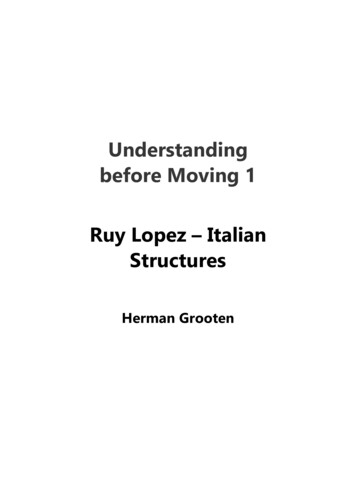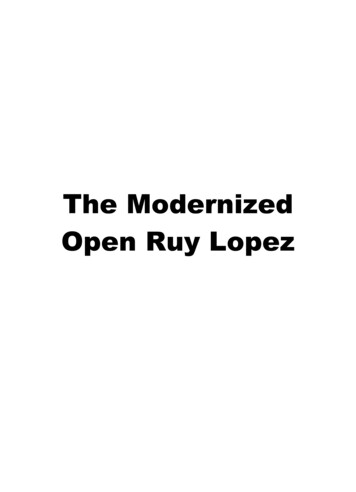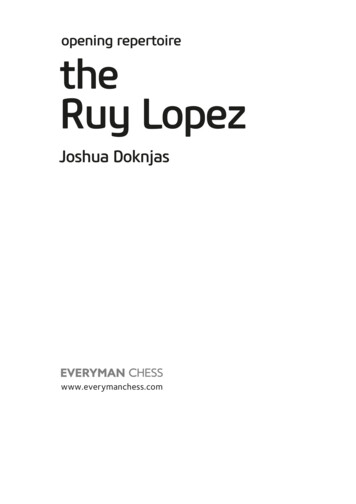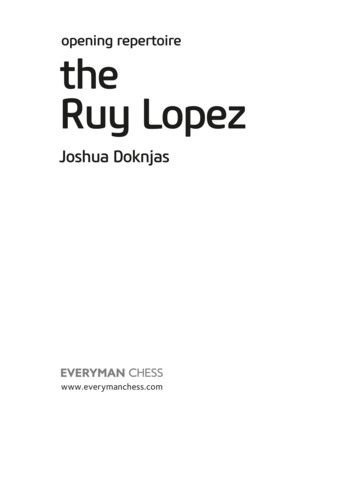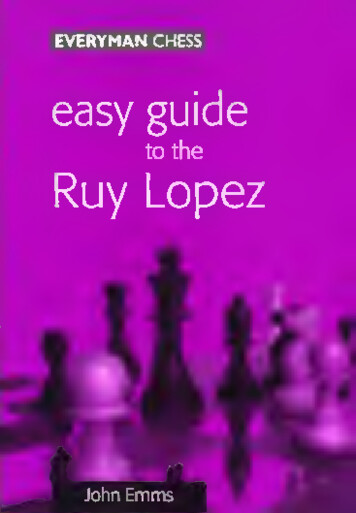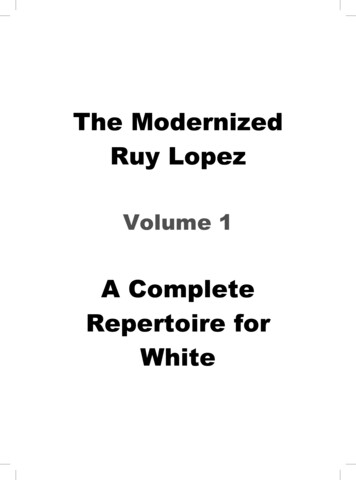
Transcription
The ModernizedRuy LopezVolume 1A CompleteRepertoire forWhite
First edition 2021 by Thinkers PublishingCopyright 2021 Dariusz ŚwierczAll rights reserved. No part of this publication may be reproduced, stored in a retrieval system or transmitted in any form or by any means, electronic, mechanical,photocopying, recording or otherwise, without the prior written permission fromthe publisher.All sales or enquiries should be directed to Thinkers Publishing, 9850 Landegem,Belgium.Email: info@thinkerspublishing.comWebsite: www.thinkerspublishing.comManaging Editor: Romain EdouardAssistant Editor: Daniël VanheirzeeleTypesetting: Mark HaastProofreading: Daniel FernandezSoftware: Hub van de LaarCover Design: Iwan KerkhofGraphic Artist: Philippe TonnardProduction: BESTinGraphicsISBN: 9789464201031D/2020/13730/32
The Modernized Ruy LopezVolume 1A Complete Repertoirefor WhiteDariusz ŚwierczThinkers Publishing 2021
I dedicate this book tomy lovely wife Keyla, with whom I share my life and who lovesme and supports me every day,my parents, Mamuś Ela and Tati Jurek, without whom I wouldhave never achieved anything,my sister Ola, BIL Wit, Otylia and Marek, who root for me inevery game I play,my grandma Irena (R.I.P), who always believed in me,my grandpa Rysiek (R.I.P), who taught me the game of chess.I wanted to say thank you and I love you!
Key to Symbols!?!!?!?! N a good movea weak movean excellent movea blunderan interesting movea dubious moveonly movenoveltylead in developmentzugzwangequalityunclear positionwith compensation for thesacrificed material - #White stands slightly betterBlack stands slightly betterWhite has a serious advantageBlack has a serious advantageWhite has a decisive advantageBlack has a decisive advantagewith an attackwith initiativewith counterplaywith the idea ofbetter isworse ischeckmate
Table of ContentsKey to Symbols . 6Foreword by Le Quang Liem . 9Introduction . 10PART I – Alternatives to the modern major linesChapter 1 – Questionable setups for Black . 15Chapter 2 – Bird’s Defense. 19Chapter 3 – Schliemann Defense. 31Chapter 4 – Cozio Defense . 53Chapter 5 – Smyslov Defense. 73Chapter 6 – Classical Defense. 91Chapter 7 – Steinitz Defense . 111Chapter 8 – Norwegian Variation . 145Chapter 9 – Averbakh Variation . 151PART II – Berlin DefenseChapter 10 – 4.0-0: Sidelines on move 4 . 173Chapter 11 – 4.0-0: Sidelines on move 5 and 6 . 179Chapter 12 – 4.0-0: Black plays 7.Nf5. 201Chapter 13 – 4.0-0: Black plays 7.Nxe5 . 239Chapter 14 – 4.d3: Sidelines on move 4 . 303Chapter 15 – 4.d3: Black plays 4.d6. 315Chapter 16 – 4.d3: Black plays 4.Bc5 . 337PART III – Ruy Lopez Open DefenseChapter 17 – Sidelines on move 6 and 7. 391Chapter 18 – White plays 8.Nxe5. 405Chapter 19 – White plays 8.dxe5 (9.Bc5 and 9.Nc5) . 425Chapter 20 – White plays 8.dxe5 (9.Be7). 469
Foreword“If you want to become a better chess player, learn the Ruy Lopez opening.” Thosewords of wisdom were given to me by one of my first coaches when I was a sevenyear-old kid in Vietnam. As I made my way into the world’s top forty, I have realizedthat my coach’s statement could not be more accurate. Throughout myprofessional career of more than 20 years competing in strong tournaments all overthe world, the Ruy Lopez has appeared countless times in my practice with bothcolors. The main challenge in studying this fascinating opening, in my humbleopinion, is to dissect the vast amount of options and absorb the most relevantinformation for your game. In the absence of an experienced coach who can guideyou through those steps, a chess player may spend weeks studying the Ruy Lopez,yet he or she may not fully understand the strategic ideas behind long variations.That challenge is now solved by Grand Master Dariusz Swiercz with the book youhave just opened. I have known Dariusz for several years since we both immigratedto the United States. As colleagues and friends, I have become acquainted with hishigh-quality chess preparation. His opening ideas, always backed up by thoroughanalysis with trusted engines, are original and sound. Dariusz has used thatprincipled approach to cover all variations of the Ruy Lopez. His dedication toproviding you a quality guidance has been very impressive in this book. He does notshy away from complications or from sharing his own novelties. In critical positions,he explains very well the ideas and plans for both sides, which should help you gaina deeper understanding of the system beyond memorization of the moves.The Ruy Lopez is such a classic opening that never gets old. Regardless of what youalready knew about this opening, there are always new ideas to be found andtested over the board. That is why this book is beneficial to chess players andenthusiasts at all levels, including top Grand Masters like myself. Reading the firstvolume of this book has been inspiring, as I feel that I have broadened my chessknowledge in certain variations. I am eagerly waiting to try Dariusz’s solidrecommendations in my future games, and I look forward to the second volume ofhis series. Overall, I highly recommend this book to anyone interested in the RuyLopez.Le Quang LiemGrand Master, former World Blitz ChampionSaint Louis, August 2020
IntroductionDear Reader,I appreciate that you are reading my book and I wanted to thank you for doing so.It is the first book that I have ever written, and it really means a lot to me.When I decided to write a book on the Ruy Lopez, covering a entire repertoire forWhite, I initially did not realize the volume of work that lay ahead of me. I haveplayed the Ruy Lopez for many years with both colors and believed that I have goodknowledge about this opening. I thought that armed with my knowledge I couldeasily write a book about it. Nothing could be further from the truth! While writingthis book, I discovered that the number of resources and lines that Black has hereis astonishing. To provide very good material that would satisfy not only the Reader,but also myself, I decided to cover the entire opening in two volumes.The first volume includes three parts. The first part is about Black’s alternatives tothe modern major lines. Even though they are not as frequent as lines that I coverin subsequent chapters or volumes, I believe that it is good to know what to do inless popular variations too. After all, why would we study only (say) the BerlinDefense, leaving our opponents able to surprise us with the sharp SchliemannVariation? From a practical point of view, such a line would be very hard to faceover the board from both chess and psychological perspectives. Basic knowledge ofsidelines is therefore important.The second part I devote to the extremely solid Berlin Defense. The amount oftheory in this opening has grown exponentially in recent years, as basically all thetop players go for it with at least one color. I will try to shed some light on thiscomplex line and try to show different ways in which White can try to get anadvantage out of the opening.Finally, in the third part I discuss the Open Ruy Lopez. Similarly to the Berlin, thetheory has developed immensely here in recent years. I will try to show someinteresting lines and ideas that challenge this opening.I would like to note one thing. Chess is a game where, with perfect play, Blackshould be always able to equalize. However, equal positions do not mean that thegame should end in a draw. In many lines (especially in the Berlin), the positions are
simply equal if Black does everything correctly. There is no way to prevent that.However, I aim to show lines that can possibly create practical problems for youropponents. Very often the objective evaluation does not really matter if a playerknows what he or she is doing while his or her opponent does not. Having a clearidea about the plans and where to put one’s pieces, as well as a general “feeling”for the position, is way better than knowing that 0.23 is shown by an engine andnot having any idea what to do next. And this is the primary goal of this book – toprovide to the Reader various ideas in the Ruy Lopez that could be used to theReader’s advantage in practical games. This would increase the chances ofopponents making mistakes (by driving them out of their comfort zone) andtherefore also your winning chances.I hope that this book will be a great journey for the Reader in exploring theintricacies of the Ruy Lopez, and that reading it will bring success in terms of wongames.Thank you,Dariusz Świercz
Part IAlternatives to themodern major lines
Questionable setupsfor Black1.e4 e5 2.Nf3 Nc6 3.Bb5
16The Modernized Ruy Lopez – Volume 11. e4 e5 2. Nf3 Nc6 3. Bb5Qxd4 Qxb5 11. Nc3 – White's development advantage is overwhelming.] 8. Nc3 Nge7 9. 0-0 d5 10.Ne2!? White's idea is Nf4 and he issimply much better.A2) 4. g5 5. d4 g4 6. Nxe5 Nxe5 7.dxe5 Qxe5 8. Bd3 is definitely anoverly ambitious approach by Black.Position after: 3. Bb53. Bb4?!B) 3. f6? 4. d4 exd4 5. Nxd4 is justawful for Black.C) 3. Qe7? 4. 0-0 and d4 next.A very rare move and, to be honest, itdoes not look good for Black. However,it has been employed by Magnus Carlsen (mostly rapid, blitz or onlinegames), so I think it deserves attention!A) 3. Qf6? 4. c3! followed by d4 givesWhite a big advantage immediately:D) 3. Na5? - honestly, nearly everything is great for White! 4. c3 [4. d4 ]E) 3. g5? 4. d4 – is just crushing in thecenter.F) 3. Bd6?! 4. 0-0 Nge7Position after: 4. Nge7Position after: 4. c3!A1) 4. Bc5 5. d4 exd4 6. e5 Qg6 7.cxd4 White has a strong center. The.Qf6-.Qg6 manoeuvre does notlead to anything special for Black. 7.Bb4 [7 Nxd4? 8. Nxd4 Qb6 ispossible but after 9. Be3 Bxd4 10.This is a really awkward setup andWhite can just build a strong centerwith great prospects: 5. c3 0-0 6. d4Ng6 7. Be3 .G) 3. d5? 4. Nxe5 just loses immediately: 4. Qg5 5. Nf3!
Part I. Chapter 1: Questionable setups for Black17I believe that this is an attempt tosimply put the line out of business. Theidea is to chase the bishop away from a5and play d4 as soon as possible.5. Bb6Position after: 5. Nf3!5. Qe7 [5. Qxg2 6. Rg1 Qh3 7.exd5 –] 6. e5 –5. Nge7 allows 6. Nxe5 just grabbingthe pawn. 6. Nxe5 7. Qxa5 6. d4H) 3. b6? A hard move to fathom.4. 0-0 Bb7 5. Bxc6 dxc6 6. Nxe5 –I) 3. a5? 4. 0-0 is also just much better for White.4. c3 Ba5Position after: 6. d46. Nf66. exd4 7. cxd4 and White will get toplay d5 next: for instance, 7. Nge7 8.d5 simply looks terrible for Black.Position after: 4. Ba5Here, White can play Bxc6 and Nxe5with a clear edge, but I found somethingeven stronger:5. Qa4!7. 0-0!I believe that this is the simplest.7. Nxe4 8. Re1!Forcing Black to play .f5.
18The Modernized Ruy Lopez – Volume 110. Nxe5 0-0 11. Qb3 Qd5 12. f3Nf6 13. Be3 Position after: 8. Re1!8. f5A) 8. d5 9. Bxc6 bxc6 10. Qxc6 –B) 8. Nd6 9. Bxc6 dxc6 10. Rxe5 Kf8 11. c4 –9. Bxc6 dxc69. bxc6 leaves the queen on d8.trapped! 10. Rxe4 fxe4 11. Bg5 –Position after: 13. Be3 White has a huge advantage. Thebishop on b6 is actually completely outof the game, meaning that White is insome sense “a piece up”!Personally, such bishops always remindme of the classic game Winter– Capablanca, 1919.
The Ruy Lopez is such a classic opening that never gets old. Regardless of what you already knew about this opening, there are always new ideas to be found and tested over the board. That is why this book is beneficial to chess players and enthusiasts at all levels, including top Grand Masters like myself. Reading the first
